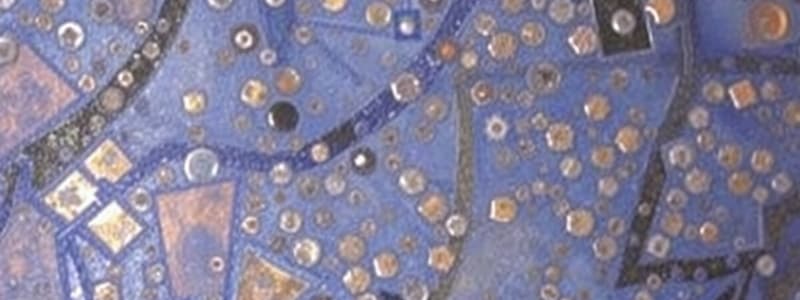Podcast
Questions and Answers
What is the role of selective media in the MPN method when estimating microbial numbers?
What is the role of selective media in the MPN method when estimating microbial numbers?
Selective media allows for the growth of specific microorganisms while inhibiting others, which aids in accurately determining the MPN of targeted microbes.
How does the enrichment culture technique support the MPN method in microbial analysis?
How does the enrichment culture technique support the MPN method in microbial analysis?
Enrichment culture techniques improve the detection of microbes by increasing their numbers in a sample before they are quantified using MPN.
Explain the viable but nonculturable (VBNC) state and its significance in the MPN estimation.
Explain the viable but nonculturable (VBNC) state and its significance in the MPN estimation.
VBNC refers to bacteria that are alive but cannot be cultured in laboratory conditions, complicating MPN estimations since they may not be detected.
What is the Great Plate Count Anomaly, and how does it relate to microbial enumeration methods like MPN?
What is the Great Plate Count Anomaly, and how does it relate to microbial enumeration methods like MPN?
Discuss how the principle of extinction dilution applies to the MPN method.
Discuss how the principle of extinction dilution applies to the MPN method.
What are selective media techniques and how do they aid in isolating specific microorganisms?
What are selective media techniques and how do they aid in isolating specific microorganisms?
Describe the purpose of enrichment cultures in microbiology.
Describe the purpose of enrichment cultures in microbiology.
What does the term 'Viable But Nonculturable' (VBNC) refer to in microbiology?
What does the term 'Viable But Nonculturable' (VBNC) refer to in microbiology?
Explain the Great Plate Count Anomaly (GPCA) and its significance.
Explain the Great Plate Count Anomaly (GPCA) and its significance.
How can understanding environmental pathogens aid in protecting human health?
How can understanding environmental pathogens aid in protecting human health?
What role do selective media techniques play in detecting specific pathogens in environmental microbiology?
What role do selective media techniques play in detecting specific pathogens in environmental microbiology?
How do enrichment cultures enhance the recovery of microorganisms from environmental samples?
How do enrichment cultures enhance the recovery of microorganisms from environmental samples?
What does the term 'Viable But Nonculturable' (VBNC) mean in the context of environmental microbiology?
What does the term 'Viable But Nonculturable' (VBNC) mean in the context of environmental microbiology?
What is the Great Plate Count Anomaly and why is it significant in microbiology?
What is the Great Plate Count Anomaly and why is it significant in microbiology?
Why is it important to understand the limitations of culturing techniques in environmental microbiology?
Why is it important to understand the limitations of culturing techniques in environmental microbiology?
How does the use of specific enrichment cultures assist in the detection of waterborne pathogens?
How does the use of specific enrichment cultures assist in the detection of waterborne pathogens?
In what ways do selective media and enrichment cultures complement each other in microbiological studies?
In what ways do selective media and enrichment cultures complement each other in microbiological studies?
What are some challenges faced when trying to detect VBNC microorganisms in environmental samples?
What are some challenges faced when trying to detect VBNC microorganisms in environmental samples?
Flashcards are hidden until you start studying
Study Notes
Most Probable Number (MPN)
- MPN is a statistical method used for estimating viable microbes in samples like food or water.
- Involves serial dilutions and monitoring growth in selective culture mediums.
- Determined by identifying the last tube with growth, which originated from ten or fewer bacteria.
- Useful for low concentrations of microorganisms, helping to derive MPN per mL of the sample.
- Can also estimate viable organisms using nonselective complex media.
- Traditional enumeration methods are time-consuming and labor-intensive.
- MPN relies on the principle of extinction dilution to assess bacterial viability.
Great Plate Count Anomaly (GPCA)
- GPCA refers to the discrepancy between microscopy counts and the number of cultivable colonies from natural samples.
- Some observed microorganisms may be non-viable or in viable but non-culturable (VBNC) states.
- VBNC organisms demonstrate motility, division, and stain positively with living cell dyes but fail to grow in laboratory conditions.
Water Quality and Public Health
- Historical focus on environmental microbiology began with concerns about waterborne pathogens impacting public health.
- Typhoid fever and cholera cases were notably associated with poor water quality.
- Filtration and chlorine disinfection were primary methods used to address waterborne diseases, although not entirely effective against all pathogens.
- In the 1960s, a false sense of security arose regarding waterborne illnesses, underestimating viruses and protozoa.
- Giardia and Norovirus proved to be resistant and were discovered in disinfected drinking water.
- Waterborne diseases account for 50% of diarrhea-associated illnesses worldwide.
Sample Collection and Processing
- Essential steps in environmental microbiology include sample collection, microscopy, culturing, and various detection methods (immunological and nucleic acid-based).
- Understanding pathogen habitats is crucial for effective culturing and elimination strategies in food and water.
Civilization and Modernization
- Human and environmental hygiene advancements have significantly reduced human suffering related to infectious diseases over the past century.
- Ongoing challenges involve rapidly detecting and eliminating pathogens to ensure public health and safe food consumption.
Studying That Suits You
Use AI to generate personalized quizzes and flashcards to suit your learning preferences.



